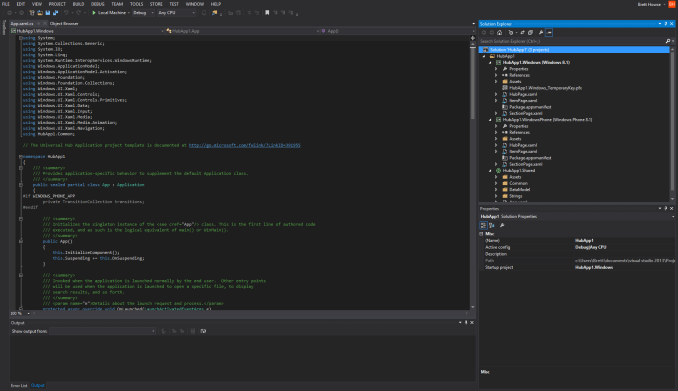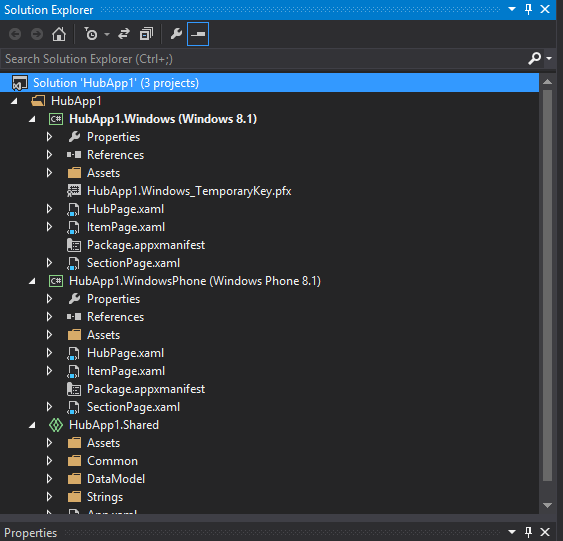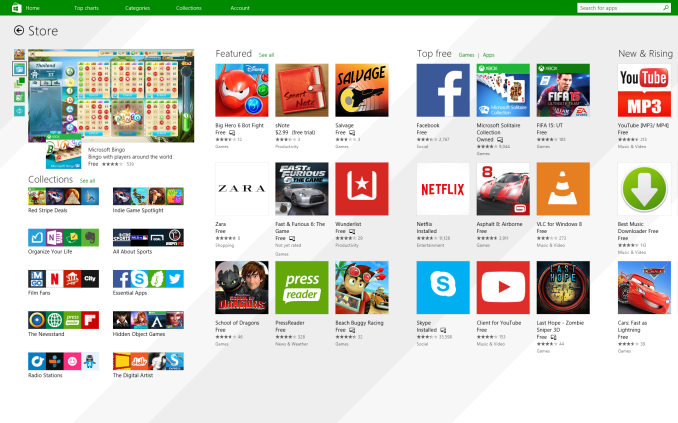Windows 10 Technical Preview First Impressions: The Return Of The Desktop
by Brett Howse on November 13, 2014 8:00 AM EST- Posted in
- Software
- Microsoft
- Windows 10
Universal Apps and the Windows Store
We just got done discussing why a single user interface for the OS across multiple devices is not always the ideal solution, so of course the obvious question with Universal Apps is why would you want it with the app model instead? Thankfully this is not the case although the term Universal App might lead people to believe they are attempting to have a single app target all of their platforms. The truth of the matter is that Universal Apps are Universal in the sense that they share a common app store.
If Microsoft is going to have Windows 10 succeed on desktops, laptops, tablets, phones, and even Xbox One, they need developer buy-in. A platform without apps is not much use to anyone. With the Universal App, they can bridge all of their platforms with a single App in the store. Under the hood, each app is created with a common framework of code, as well as multiple user interfaces in order to tailor the experience to the correct device type. Below is a screenshot of Visual Studio – Microsoft’s developer tools – with a new Universal App about to be created.
 Visual Studio Showing a Universal App Project
Visual Studio Showing a Universal App Project
As you can see, there is a shared portion of code, and then a project for the UI for Windows 8.1, and Windows Phone 8.1. Xbox One is not available yet, but should be added in a future release of Visual Studio.
A close up of the projects
But you may be wondering why any of this is necessary. Windows has the largest selection of applications of any system ever. That is of course true, and the Win32 framework has served both Windows and its users well over the years. But with the new WinRT framework there are some big advantages. First, it can be written to in multiple languages including HTML. WinRT supports C++/CX, C#, VB.NET, and HTML scripting with JavaScript and TypeScript. The security model for WinRT apps is a lot different than Win32, with all WinRT apps running in a sandbox mode for higher security. Unlike apps written in .NET, WinRT is native code, which should result in better performance. Contracts and Extensions are also new to WinRT, and allow apps to share data while still being in a sandbox. One of the biggest advantages of WinRT is that it is DPI aware, and can automatically scale apps appropriately based on screen size and screen resolution. Here, as we know, Win32 apps can struggle even though there are solutions in place.
Adobe Touch WinRT (left) vs Adobe Reader Win32 (right) on HiDPI display
One of the biggest disadvantages of WinRT is that it is only available on Windows 8 and newer devices. With Windows 8 struggling in the market as compared to Windows 7, the user reach of a developer targeting WinRT apps in the Windows Store would be for a subset of the total user base. With Windows 7 having over 50% of the desktop OS market share to itself, this is going to be an issue.
With Windows 10, Microsoft is certainly targeting Windows 7 users. If they can convince them to upgrade to the latest version of the operating system, then the new environment will have a much larger target base and will hopefully encourage developers to target the Windows Store. We have not heard of any upgrade promotions or pricing yet, but this is one of the biggest advantages Apple has had over the years. Their user base generally upgrades the OS at a much faster uptake than Windows. This allows developers to utilize newer APIs in the latest versions of their operating systems and keep the platform progressing. Microsoft has already had to deal with people being stuck on Windows XP, and they must be wanting to avoid that with Windows 7.
Since we are discussing Universal Apps and their advantages, one of the biggest advantages is the Windows Store. With Microsoft hosting the entire download and purchase of all WinRT apps, having user settings and apps sync from one device to another is much easier. One of the greatest experiences with Windows 8.1 is signing into a new PC for the first time. When you log in with your Microsoft Account, the system asks you if you would like to copy the devices and apps from one of your other devices, or if you want to start with a clean machine. If you choose a previous machine, all of the settings, wallpaper, Start Screen layout, and Windows Store apps are synced to the new device. In the case of Windows Store apps, the app itself is listed on your Start Screen, but it is not downloaded until the first time you select it. This avoids a situation where you will significantly delay the initial login time with a massive download, as well as avoid filling the available storage with apps you may not need on that particular device.
Also, like modern tablet and smartphone OSes, WinRT apps from the store are automatically kept up to date by the store. This avoids a lot of the issues with viruses and malware attacking an older version of a product since in theory it will not be around any longer.
The one thing missing from this are the older Win32 apps on the desktop, because they are not available in the Windows Store. Prior to Windows 10, desktop apps could be listed in the store, but the store would then link to the developer’s website to allow you to purchase and install the app. With Windows 10, rumors are that desktop apps will also be available and managed through the Windows Store. Assuming this does happen, then this will be a major boon to users. Desktop apps should in theory also be able to be kept up to date using the Windows Store which should cut back on the number of outdated pieces of software targeted by malware.
The Windows Store is a key piece of Windows 10. Universal Apps can be made available for multiple platforms through the store, and, if the rumors are true, even desktop apps will be available through the store. This should make the Out Of Box Experience (OOBE) very good for users with a Microsoft Account. The WinRT framework has not yet had the killer app written for it, so hopefully with Windows 10 the framework will be expanded to allow for more powerful apps to be created.













198 Comments
View All Comments
Imaginer - Thursday, November 13, 2014 - link
I personally WANT to KEEP the Start Screen on my desktop systems.The All Apps area does need improvement, in zeroing in on the selected folders when zooming out (by CTRL mouse wheel). The folders do need to be differentiated by color boxes.
I have absolutely no use of launching any application by desktop icons anymore, only using this area for scratch files I use.
And I have no need for a limited Start Menu pinning, where on the Start Screen I can pin an "infinite" amount of tiles, with a quick reveal with the Start key or the Start button.
Options. I know that it can be given. Much like there is backlash, I am giving my own if I do not keep my Start Screens on my pure desktop PCs. Otherwise, the rejoice of "return of desktop" is unwarranted, as FIle Explorer, Task Manager, Right Click power options, and Taskbar are all there to begin with.
Imaginer - Thursday, November 13, 2014 - link
I really am not that interested in drop shadows, but it is a graphical draining feature I can turn off, as in my Tablet PC of a Surface Pro 2, most if not all the time I am running windows maximized. And on the desktop, most to all of my monitors run as close to maximized.I don't mind that flat look, it is superficial at this point, to appease the "prettiness" type of people.
Brett Howse - Thursday, November 13, 2014 - link
You can use the Start Screen instead of the Start Menu it's just a checkbox in the Start Menu properties. Once Continuum appears, it will be even easier to switch since you can likely manually invoke that feature.zero2dash - Thursday, November 13, 2014 - link
I've played around with it in a VM, and it's certainly better than 8/8.1 but I don't think it's any better than 7 and I'm happy with (and used to) 7. Even if 10 is a free upgrade for 7 users, I don't think I'd take it.Seems like they've moved things around a bit in 10 (that may have also been moved in 8/8.1 and are simply in the same spot in 10), and I don't like this "relearning" that they think I have the time or energy to do. If I'm going to relearn an OS, it's gonna be Ubuntu or Fedora.
Zingam - Thursday, November 13, 2014 - link
On my left - a laptop with Windows 8.1 and on my right - a laptop with Windows 7. Conclusion: Windows 8.1 is so much nicer than Windows 7 (Windows 8 was lacking but Windows 8.1 is superior). Nuff said!Gunbuster - Thursday, November 13, 2014 - link
Is DirectAccess in the preview or do they have it locked down to "Windows 10 Enterprise" or whatever they are going to call it?I'm convinced Cisco is making payments to keep DirectAccess out of the mainstream so their VPN device customers don't instantly evaporate.
wiyosaya - Thursday, November 13, 2014 - link
In my opinion, overall cost is what drives business to move to a new OS, not features. Many businesses had only recently upgraded from NT to 7 when 8 came out. M$ seems to expect that everyone, including the business world, will just lock-step into line and upgrade at M$' slightest whim.As I see it, even without the learning curve of the new UI in 8, upgrading, after just completing an upgrade to 7, would have been prohibitively expensive for many businesses. Many articles I have seen point to the learning curve of the 8 UI as the singular reason that the business world failed to adopt it. What evidence is there for this? I am willing to bet that the main reason was cost, not learning curve - which is not all that steep except, perhaps, for the less technically inclined.
Hairs_ - Thursday, November 13, 2014 - link
The biggest hurdle for businesses is app compatibility, even more so than hardware or training costs.Businesses are still running mission critical functions on 70's mainframe systems, because replacing them is simply too expensive / frightening / difficult.
prime2515103 - Thursday, November 13, 2014 - link
Can the live tiles in the start menu be disabled and/or replaced with the selections that are in the Win7 start menu?Brett Howse - Thursday, November 13, 2014 - link
You can unpin whatever you would like from the Start Menu, and you can pin anything you'd like including desktop apps.